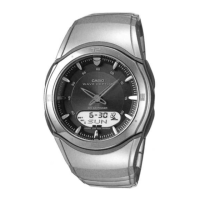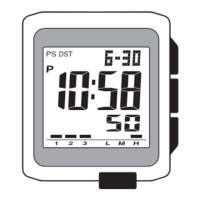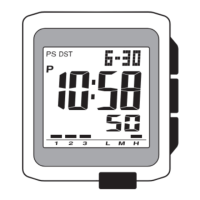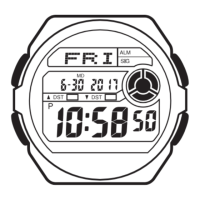Do you have a question about the Casio WVQ-400E-1A and is the answer not in the manual?
Instructions on how to charge the watch using light for optimal operation and battery life.
Explains why analog hands might stop moving due to power saving mode or depleted battery.
Provides an overview of the manual's structure, button notations, and general guidance.
Basic instructions for mode switching, using the light function, and initial setup.
Explains the watch's ability to receive time calibration signals for accurate time.
Details how to set the watch's time and date, including specifying the Home Time Zone.
How to select your primary time zone for accurate timekeeping and signal reception.
Procedure to check whether the last time calibration signal reception was successful.
Solutions for common problems encountered with time calibration signal reception.
Step-by-step guide to starting, stopping, and resetting the stopwatch function.
Instructions for browsing and displaying times from various world time zones.
Procedure for setting the correct starting positions for the analog hands.
Steps for configuring the alarm time and turning it on or off.
Details on how alarms sound and how they are managed within the watch.
Information about the automatic illumination feature and its operation.
Describes the different battery charge levels and their implications for watch functions.
Important warnings and advice regarding charging the watch safely.
Provides information on exposure times needed for charging the watch effectively.
Details the exposure time required to charge the battery from one level to another.
Step-by-step guide to manually adjusting the watch's time and date settings.
Explains how to manage Daylight Saving Time settings, including auto and manual options.
Contains additional technical details and precautions for watch operation.
Methods to re-activate the watch from its power saving sleep mode.
Describes how the watch automatically returns to the Timekeeping Mode after inactivity.
Explains the use of the B button for high-speed hand movement during settings.
Important warnings and considerations for receiving time calibration signals.
Information about the signal sources used for time calibration and selection.
A list of major cities and their corresponding GMT differentials for setting time zones.
Instructions on how to utilize the tachymeter bezel for speed calculations.
Instructions on how to charge the watch using light for optimal operation and battery life.
Explains why analog hands might stop moving due to power saving mode or depleted battery.
Provides an overview of the manual's structure, button notations, and general guidance.
Basic instructions for mode switching, using the light function, and initial setup.
Explains the watch's ability to receive time calibration signals for accurate time.
Details how to set the watch's time and date, including specifying the Home Time Zone.
How to select your primary time zone for accurate timekeeping and signal reception.
Procedure to check whether the last time calibration signal reception was successful.
Solutions for common problems encountered with time calibration signal reception.
Step-by-step guide to starting, stopping, and resetting the stopwatch function.
Instructions for browsing and displaying times from various world time zones.
Procedure for setting the correct starting positions for the analog hands.
Steps for configuring the alarm time and turning it on or off.
Details on how alarms sound and how they are managed within the watch.
Information about the automatic illumination feature and its operation.
Describes the different battery charge levels and their implications for watch functions.
Important warnings and advice regarding charging the watch safely.
Provides information on exposure times needed for charging the watch effectively.
Details the exposure time required to charge the battery from one level to another.
Step-by-step guide to manually adjusting the watch's time and date settings.
Explains how to manage Daylight Saving Time settings, including auto and manual options.
Contains additional technical details and precautions for watch operation.
Methods to re-activate the watch from its power saving sleep mode.
Describes how the watch automatically returns to the Timekeeping Mode after inactivity.
Explains the use of the B button for high-speed hand movement during settings.
Important warnings and considerations for receiving time calibration signals.
Information about the signal sources used for time calibration and selection.
A list of major cities and their corresponding GMT differentials for setting time zones.
Instructions on how to utilize the tachymeter bezel for speed calculations.












